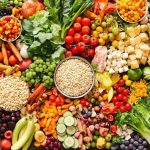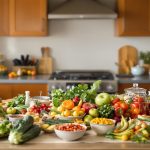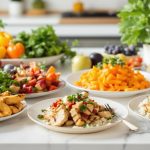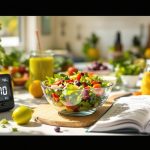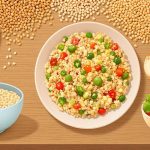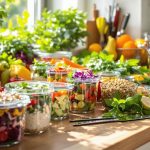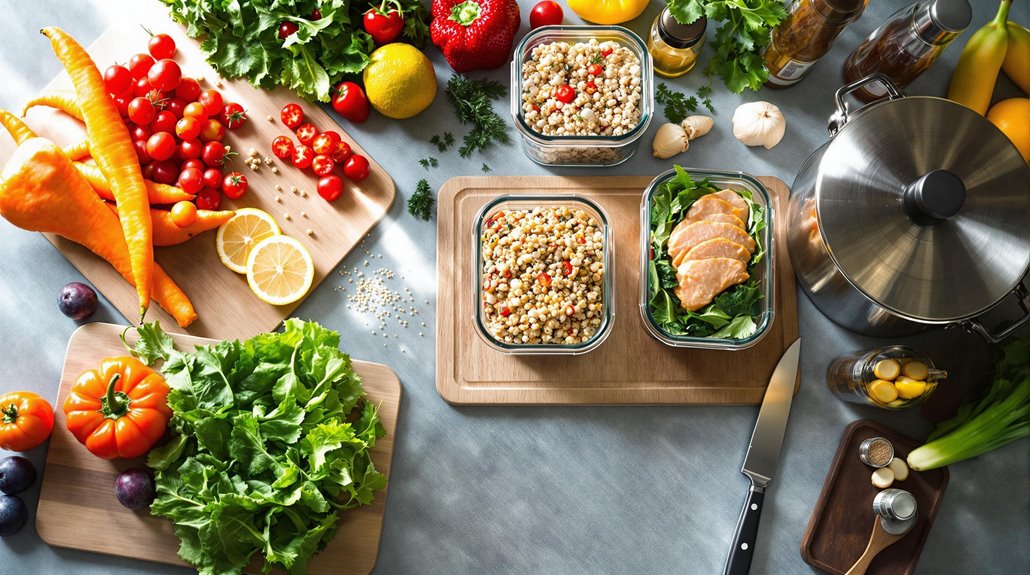
Start your nutritious meal prep journey by mastering meal planning tailored to your needs. Use seasonal ingredients, and try themed days to add excitement. Prep ingredients in advance—chop veggies, cook grains, and marinate proteins for easy access. Batch cooking also saves time and guarantees you have meals ready for the week. Invest in safe, stackable storage containers and prepare healthy snacks like energy balls for quick bites. Keep recipes simple with meals like turkey chili. Balance your meals with lean proteins and colorful veggies. Consider a structured grocery plan to avoid impulse buys and focus on nutritious choices. Discover even more by exploring further.
Master Meal Planning
In the domain of mastering meal planning, you must first develop a weekly or monthly plan that caters to your nutritional needs and lifestyle. Start by embracing meal variety through seasonal ingredients, not only saving money but also enhancing the flavors of your dishes. Create a collection of recipes that match your cooking skills and explore exciting recipe themes like Meatless Mondays or Whole Grain Wednesdays for a creative twist. Incorporating favorite foods into your meal prep allows for personalized and enjoyable meals that keep everyone satisfied. For those aiming for weight management, be mindful of portion control to ensure that caloric intake aligns with weight loss goals. Organize your pantry to efficiently use existing ingredients and incorporate easy substitutions when necessary. Meal customization is your ticket to freedom in the kitchen. By tailoring meals to individual preferences, you’re not shackled by one-size-fits-all recipes. Engage your family in meal planning for a collaborative effort that reflects everyone’s tastes. It also helps to keep your culinary journey fun and flexible, aligning with your schedule and needs. Don’t overlook the power of reviewing your pantry and fridge. It’s a treasure trove waiting for creative repurposing and efficient use, ensuring nothing goes to waste.
Efficient Ingredient Prep
Building upon your mastery of meal planning, efficient ingredient prep becomes the key to streamlining your cooking process and maximizing your time in the kitchen. Imagine a world where cooking is less about hectic rushes and more about creative freedom. You’re ready to embrace efficient cooking with strategic ingredient rotation. Adequate and balanced meals are crucial for maintaining a healthy diet, ensuring you’re energized throughout the week.
Start by selecting diverse proteins like chicken, steak, or tofu, each easily prepared and stored for the week. Grains like rice, quinoa, or pasta not only bulk up your meals but freeze well for future use. With vegetables, variety is your friend: onions, garlic, and broccoli can enhance flavors, while kale offers that nutritious crunch.
Embrace multitasking by boiling proteins while roasting vegetables like fennel and Brussels sprouts. You’ll efficiently chop onions and bell peppers for versatile meals. Remember, sauces and dips like pesto or stir fry sauce can elevate a dish from basic to extraordinary, so have them prepped and ready. Efficient food prep, taking just 60 minutes, can significantly streamline your weekly cooking process.
Store these prepped treasures in labeled containers, ensuring everything’s within reach and minimizes waste. Maximize efficiency by enjoying the creative freedom of ingredient rotation.
With this approach, you’re not just cooking; you’re liberating yourself from the mundane, creating meals brimming with variety and nutrition.
Embrace Batch Cooking
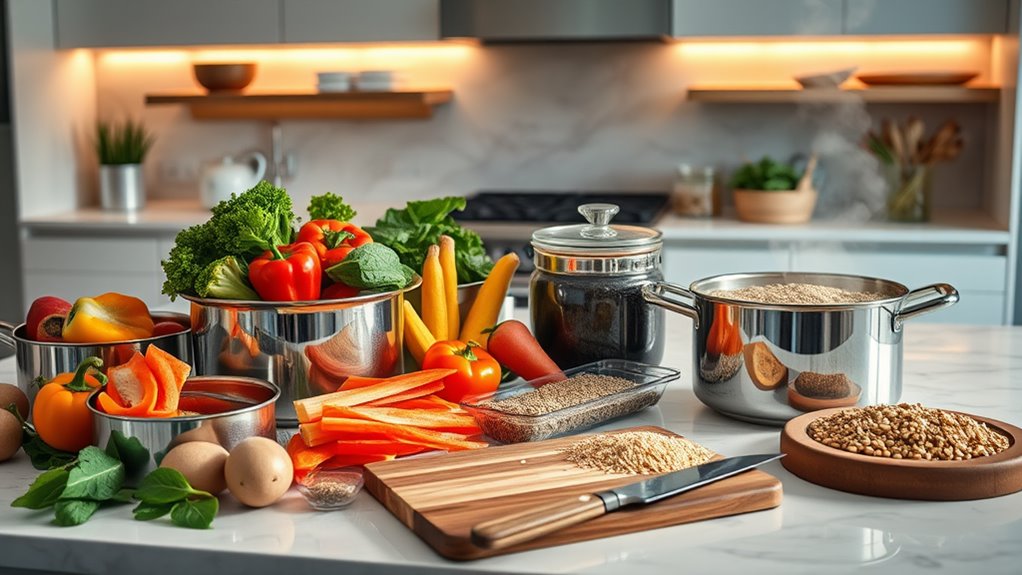
Diving into the world of batch cooking opens the door to efficiency and nutrition at its finest. Imagine cooking just once or twice a week and having nutritious meals on hand, ready to go. Batch cooking encourages wholesome food choices with higher vegetable content and meals that are lower in fat, salt, and calories. By incorporating fiber-rich foods such as whole grains and legumes, meals become even more beneficial for digestive health and overall well-being. With clever time-saving techniques, you’ll spend less time in the kitchen and more time savoring life. Batch cooking reduces the frequency of meal preparation, letting you ride a wave of liberation through planned leftovers and quick reheating.
Optimize Storage Solutions
Release the full potential of your meal prep by optimizing storage solutions that keep your food fresh and flavorful. Immerse yourself in the freedom of well-organized, accessible meal storage by focusing on smart container selection and effective storage guidelines.
With the right choices, you free your culinary creativity and nourish your body with ease.
Consider these key strategies:
- Choose Non-Toxic Materials: Prioritize containers made from non-toxic materials like glass or BPA-free plastic. Glass is perfect for its durability and versatility, while BPA-free plastic offers a lightweight, cost-effective option.
- Embrace Leak-Proof and Stackable Designs: Select containers with leak-proof lids to preserve freshness and avoid spills. Stackable designs maximize space in your fridge or freezer, guaranteeing efficient use of every inch.
- Opt for Air Release and Compartment Features: Some containers come with air release technology, enhancing freshness and preventing food bloating. Multi-compartmental options ensure portion control and effortless separation of different foods.
- Utilize Freezer-Safe Solutions: Use freezer-friendly containers or vacuum bags to fend off freezer burn. Stack these strategically to optimize space, assuring long-term storage without compromise.
Heavy-duty borosilicate glass containers are an excellent choice as they resist chipping, making them both durable and oven-safe for various meal prep needs. Companies involved in food production should never overlook the importance of allergen transparency to avoid potential health complications and regulatory issues. Compact, clever storage provides freedom from the chaos of clutter—a straightforward key to nutritious meal prep success.
Prepare Healthy Snacks
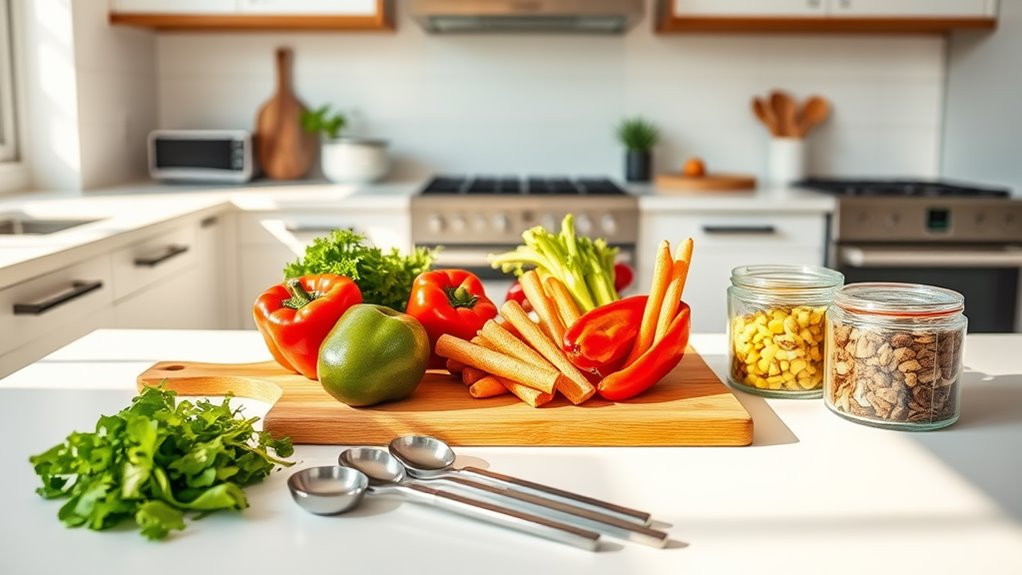
With your storage optimized for freshness, let’s explore how to prepare healthy snacks that are both nutritious and satisfying. Embrace the freedom to create your own snack customization by combining versatile ingredients and flavors.
Picture energy balls made from rolled oats, nut butter, honey, and seeds, offering both nutrition and an energy boost. Or perhaps a chia pudding soaked in milk and adorned with fruit and nuts sparks your interest, providing a high-fiber option that satisfies.
Flavor pairings can elevate your snack game. Pair fresh fruit with nuts for a balanced mix of sweetness and crunch. Dip raw veggies in hummus, savoring the contrast between crisp vegetables and creamy goodness.
For a protein-rich snack, spread peanut butter on whole grain crackers and feel the liberation of a quick yet wholesome treat. If crunch is your calling, roast chickpeas with your favorite spices or bake crispy seed crackers.
Air-popped popcorn becomes a masterpiece of simplicity, enhanced with spicy parmesan for extra zest. Remember, control portions for easy grab-and-go and ascertain snacks are stored in airtight containers.
Staying properly hydrated can complement your nutritious snacks by supporting digestion and overall energy levels. This way, you’ll always have a satisfying, healthy snack ready whenever freedom calls.
Keep Meals Simple
Keeping meals simple is all about focusing on quality over quantity. When you streamline your meal prep, you free yourself from kitchen chaos and embrace the flavors you truly love.
Start by prioritizing essential meals, planning around your week’s schedule, and focusing on meal variety to keep things exciting. Here’s a liberating approach to keeping your meals simple yet flavorful:
1. Strategically Plan Meals: Assign specific meals or foods to certain days. Opt for simple recipes like turkey chili and roasted vegetables for flexible options that enhance flavor without effort.
2. Simplify Your Grocery List: Create a list and stick to it. Use tech tools to calculate exact ingredient amounts and simplify your shopping, ensuring you only get what’s necessary and freeing yourself from impulse buys.
3. Master Prep Day: Designate a day for meal prep—cook grains and proteins first, and marinate meats for an instant flavor boost.
Prep vegetables and fruits in advance to easily incorporate them into meals.
4. Store Smartly and Reuse: Use clear containers and label prepped items. Store them smartly, with highly perishable foods up front.
Freeze portions of soups and chili for effortless future meals, preserving both time and flavor.
Ensure Nutritional Balance
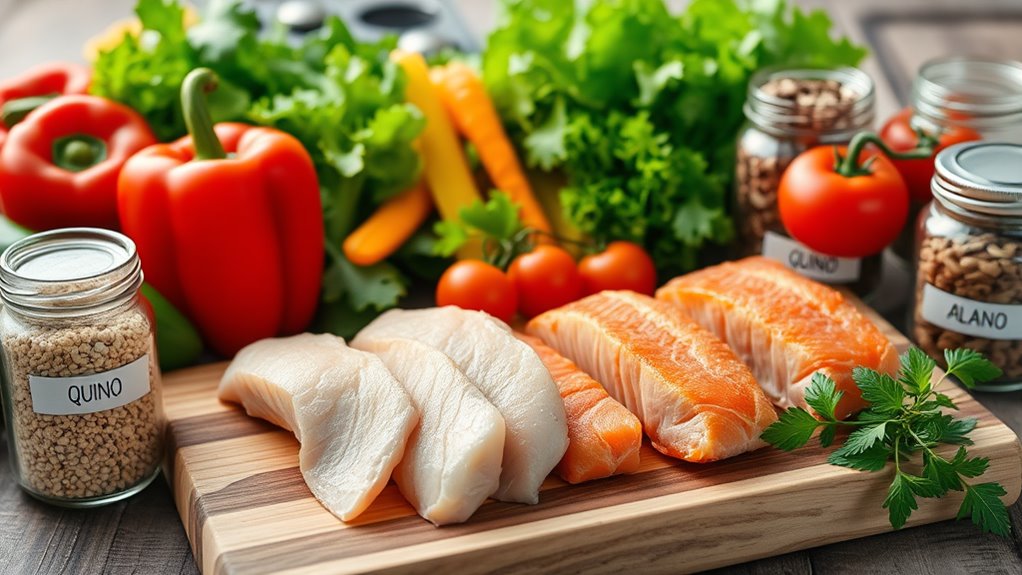
When aiming to guarantee nutritional balance, start by planning meals around a variety of essential food groups such as proteins, complex carbohydrates, fruits, and vegetables. Embrace nutrient diversity by selecting lean proteins like chicken, fish, and legumes. Make complex carbohydrates your meal’s cornerstone through whole grains and quinoa, fueling freedom with energy that lasts.
Vibrant and colorful vegetables offer crunch and creativity, so aim to incorporate at least three servings daily to keep your palate and plate lively.
Mastering portion control is key to maintaining balance. Use kitchen scales or measuring cups for precise portion sizes, and divide meals into individual containers. This strategy keeps your nutritional goals on track while ensuring meals are ready to grab and go, liberating time for pursuits beyond the kitchen.
Opt for whole, unprocessed ingredients; they’re nutrient-dense and align beautifully with health-conscious ambitions. Gentle reliance on MyPlate guidelines can keep your meals proportionate and complete, honoring every essential food group’s role.
End With Weekly Shopping Strategy
A well-structured weekly shopping strategy is pivotal to achieving efficient nutritious meal preparation. Throughout this article, we’ve explored essential components such as meal planning, grocery list preparation, ideal shopping techniques, and post-shopping strategies. By meticulously planning each stage, not only can nutritious eating be accomplished seamlessly but also time and money can be managed more effectively.
The first step in meal prep is to map out the week’s meals, focusing on nutrition and versatility. Developing a detailed grocery list requires confirming what’s already in stock and organizing the remaining items by store layout.
Next, executing efficient shopping involves setting a regular shopping day, utilizing online tools, and taking advantage of discounts. Upon returning home, properly unpacking and storing ingredients guarantees they stay fresh and easily accessible. Preparing ingredients ahead aids in swift meal assembly during the weekdays, ultimately fostering a less stressful kitchen routine.
In committing to these practices, not only does one promote a balanced diet, but they also contribute to a more sustainable lifestyle by reducing food waste and unnecessary consumption. To sustain this routine, regularly assess and refresh your meal plan and shopping list while adapting to seasonal changes and family preferences.
Such engagement not only maximizes the potential of nutritious meals but also cultivates confidence and creativity in meal preparation. Prioritizing organization and mindfulness in shopping and meal prep not only nourishes the body but also nurtures an efficient and stress-free environment in the kitchen.
Ultimately, embracing these strategies contributes greatly to overall health and wellbeing, making it easier to maintain wholesome eating habits in our busy lives.

